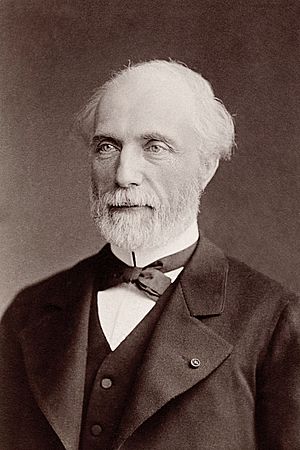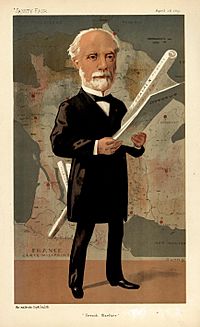Charles de Freycinet facts for kids
Quick facts for kids
Charles de Freycinet
|
|
|---|---|

Freycinet (c. 1880) by Nadar
|
|
| Minister of War | |
| In office 1 November 1898 – 18 February 1899 |
|
| Prime Minister | Charles Dupuy |
| Preceded by | Charles Chanoine |
| Succeeded by | Camille Krantz |
| In office 3 April 1888 – 10 January 1893 |
|
| Prime Minister | Charles Floquet Pierre Tirard Himself Émile Loubet Alexandre Ribot |
| Preceded by | François Logerot |
| Succeeded by | Julien Loizillon |
| Prime Minister of France | |
| In office 17 March 1890 – 27 February 1892 |
|
| President | Sadi Carnot |
| Preceded by | Pierre Tirard |
| Succeeded by | Émile Loubet |
| In office 7 January 1886 – 16 December 1886 |
|
| President | Jules Grévy |
| Preceded by | Henri Brisson |
| Succeeded by | René Goblet |
| In office 30 January 1882 – 7 August 1882 |
|
| President | Jules Grévy |
| Preceded by | Léon Gambetta |
| Succeeded by | Charles Duclerc |
| In office 28 December 1879 – 23 September 1880 |
|
| President | Jules Grévy |
| Preceded by | William Waddington |
| Succeeded by | Jules Ferry |
| Minister of Foreign Affairs | |
| In office 28 December 1879 – 3 December 1886 |
|
| Prime Minister | Himself Henri Brisson |
| Preceded by | Paul-Armand Challemel-Lacour |
| Succeeded by | Émile Flourens |
| Minister of Public Works | |
| Prime Minister | Jules Dufaure William Waddington |
| Preceded by | Michel Graeff |
| Succeeded by | Henri Varroy |
| Member of the French Senate for Seine |
|
| In office 30 January 1876 – 11 January 1920 |
|
| Succeeded by | Louis Dausset |
| Personal details | |
| Born | 14 November 1828 Foix, Ariège, France |
| Died | 14 May 1923 (aged 94) Paris, France |
| Political party | Republican Union (1871–1885) Union of the Lefts (1885–1894) League of Patriots (1894–1923) |
| Spouse |
Jeanne Alexandrine Bosc
(m. 1858; died 1923) |
| Education | École Polytechnique |
| Profession | Engineer |
Charles Louis de Saulces de Freycinet (born November 14, 1828 – died May 14, 1923) was an important French leader. He served as the Prime Minister four times during the Third Republic. He also held the important job of Minister of War for a long time (1888–1893). He was part of the Opportunist Republicans political group.
Freycinet was chosen as a member of the Academy of Sciences. In 1890, he also became a member of the Académie Française, a famous French council for arts and literature.
Contents
Biography
Early Life and Career
Charles de Freycinet was born in Foix, France. He came from a Protestant family. His uncle, Louis de Freycinet, was a famous French explorer. Charles studied at the École Polytechnique, a top engineering school.
After his studies, he became a mining engineer for the government. In 1858, he started working as a traffic manager for a railway company. He was very good at organizing things. Later, in 1862, he went back to engineering. By 1886, he was a top inspector. He also went on special science trips, including one to the United Kingdom. There, he wrote a report about working conditions for women and children in English factories.
Role in the Franco-Prussian War
In July 1870, the Franco-Prussian War began. This war led to the end of the Second French Empire. When the Third Republic was formed in September 1870, Freycinet offered his help. He was made a local leader (prefect) and then became the head of the military office.
Freycinet was very skilled at organizing. He helped Léon Gambetta create many new armies to fight the German invaders. He was a good planner for military actions. However, his plans sometimes caused problems with the generals on the battlefield. This led to some difficulties for the French army.
Political Career (1871-1888)
In 1871, Freycinet wrote a book defending his work during the war. In 1876, he joined the Senate, following Léon Gambetta. In December 1877, he became the Minister of Public Works.
He created a big plan to buy railways for the state and build new lines. This plan also aimed to improve the canal system in France. He kept his job when William Henry Waddington became Prime Minister. In December 1879, Freycinet himself became Prime Minister and Minister for Foreign Affairs.
He allowed people who had been involved in the Paris Commune to return to France. However, he tried to find a middle ground on religious issues. This made him lose support from Gambetta, and he resigned in September 1880.
In January 1882, he became Prime Minister and Foreign Minister again. France did not want to join Britain in attacking Alexandria in Egypt. This weakened France's influence in Egypt. Freycinet tried to find a compromise, but his plan was rejected. His government then resigned.
He returned to government in April 1885 as Foreign Minister. In January 1886, he became Prime Minister again. He had many plans for changes within France. But his main successes were in expanding France's colonies. He was a skilled politician, but he couldn't keep his political group united. He was defeated in December 1886.
The next year, he tried to become President of France. But some politicians did not like his flexible approach. They voted for Marie François Sadi Carnot instead.
Minister of War
In April 1888, Freycinet became the Minister of War. He was the first civilian (non-military person) to hold this job since 1848. His work in this role was his greatest achievement. He held this position for five years straight, serving under several different governments.
He was responsible for important changes in the French army. These included introducing three years of military service for soldiers. He also helped create a general staff and a supreme council for the army. His time as Prime Minister saw many debates about religious matters. A vote against his bill on religious groups led to the fall of his government.
He faced some questions about his involvement in a financial scandal. In January 1893, he resigned as Minister of War. In November 1898, he became Minister of War again. But he resigned from this position on May 6, 1899.
Prime Minister of France
Charles de Freycinet served as Prime Minister of France four times. During his time as Prime Minister, he also held other important roles, such as Minister of Foreign Affairs or Minister of War. He led several governments, working with different ministers to manage France's affairs.
- First Government (1879-1880): He was Prime Minister and Foreign Minister.
- Second Government (1882): He was Prime Minister and Foreign Minister again.
- Third Government (1886): He served as Prime Minister and Foreign Minister.
- Fourth Government (1890-1892): He was Prime Minister and Minister of War.
These governments focused on various issues, from public works and foreign policy to military reforms.
Images for kids
-
Freycinet (c. 1880) by Nadar
See also
 In Spanish: Charles de Freycinet para niños
In Spanish: Charles de Freycinet para niños




